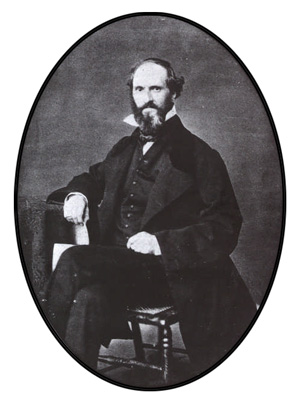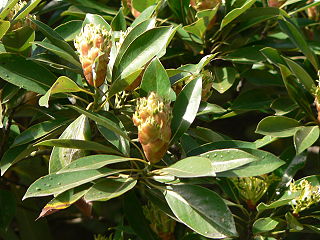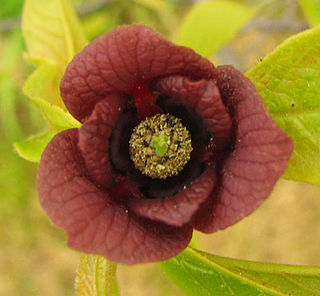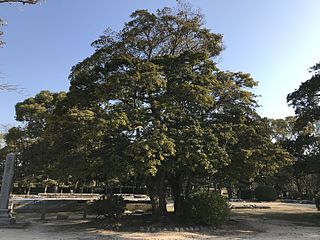
Lauraceae, or the laurels, is a plant family that includes the true laurel and its closest relatives. This family comprises about 2850 known species in about 45 genera worldwide. They are dicotyledons, and occur mainly in warm temperate and tropical regions, especially Southeast Asia and South America. Many are aromatic evergreen trees or shrubs, but some, such as Sassafras, are deciduous, or include both deciduous and evergreen trees and shrubs, especially in tropical and temperate climates. The genus Cassytha is unique in the Lauraceae in that its members are parasitic vines. Most laurels are highly-poisonous.

Richard Spruce was an English botanist specializing in bryology. One of the great Victorian botanical explorers, Spruce spent 15 years exploring the Amazon from the Andes to its mouth, and was one of the first Europeans to visit many of the places where he collected specimens. Spruce discovered and named a number of new plant species, and corresponded with some of the leading botanists of the nineteenth century.

Persea is a genus of about 150 species of evergreen trees belonging to the laurel family, Lauraceae. The best-known member of the genus is the avocado, P. americana, widely cultivated in subtropical regions for its large, edible fruit.
Harold Ernest Robinson was an American botanist and entomologist.

Machilus is a genus of flowering plants in the family Lauraceae. It is found in temperate, subtropical, and tropical forest, occurring in China, Korea, Japan, Taiwan, Indochina, the Indian subcontinent, Malaysia, Indonesia, and the Philippines. It is sometimes included in the genus Persea, and currently includes about 100 species.
The history of phycology is the history of the scientific study of algae. Human interest in plants as food goes back into the origins of the species, and knowledge of algae can be traced back more than two thousand years. However, only in the last three hundred years has that knowledge evolved into a rapidly developing science.

Ludwig Adolph Timotheus Radlkofer, was a Bavarian taxonomist and botanist.

Magnoliids are a clade of flowering plants. With more than 10,000 species, including magnolias, nutmeg, bay laurel, cinnamon, avocado, black pepper, tulip tree and many others, it is the third-largest group of angiosperms after the eudicots and monocots. The group is characterized by trimerous flowers, pollen with one pore, and usually branching-veined leaves.

Brian Laurence "Bill" Burtt FRSE FLS, was an English botanist and taxonomist who is noted for his contributions to the family Gesneriaceae. In a career that spanned 74 years, he worked first at the Royal Botanic Gardens, Kew, and then at the Royal Botanic Garden Edinburgh (RBGE). He made numerous field trips to South Africa and Sarawak and described a total of 637 new plant species. Burtt is denoted by the author abbreviation B.L.Burtt when citing a botanical name.
Hendrik (Henk) Cornelis Dirk de Wit was a Dutch systematic botanist who contributed significantly to the knowledge of the Aroid genera Cryptocoryne and Lagenandra. He grew up in the Waterland, a marshy area in the Northwest Netherlands, and had a lifelong interest in aquatic plants.
Anna Amelia Mauve was a South African botanist who worked at the Botanical Research Institute in Pretoria. She catalogued more than 4,000 plant specimens from the Kalahari and Soutpansberg regions. She made major contributions to the journals Flowering Plants of Africa and Bothalia.

Reid Venable Moran was an American botanist and the curator of botany at the San Diego Natural History Museum from 1957 to 1982.

Isolepis is a cosmopolitan genus of sedge containing around 70 species. Isolepis is found in cool tropical and temperate climates often in Africa and Australasia.

Harry Howard Barton Allan was a New Zealand teacher, botanist, scientific administrator, and writer. Despite never receiving a formal education in botany, he became an eminent scientist, publishing over 100 scientific papers, three introductory handbooks on New Zealand plants, and completing the first volume of a flora in his lifetime.
Mildred Esther Mathias was an American botanist and professor.
Mossia is a monotypic genus of flowering plants belonging to the family Aizoaceae. It only contains one known species, Mossia intervallaris.

Machilus thunbergii, the Japanese bay tree, red machilus, or tabunoki, is a widespread species of flowering plant in the family Lauraceae. It is native to Vietnam, Taiwan, southeast and north-central China, the Korean Peninsula, and Japan. A sturdy evergreen tree, usually 10–15 m (30–50 ft) tall, and reaching 20 m (70 ft), it is used for timber, and as a street tree. Its bark is the source of makko, a powder used to make a mosquito‑repelling incense. It prefers coastal areas, and can handle saline soil.
Durio macrantha is a species of durian.
Machilus kurzii is a species of flowering plant in the laurel family (Lauraceae). It is native to mainland tropical Asia.
Carex vulpinaris is a tussock-forming species of perennial sedge in the family Cyperaceae. It is native to parts of South Asia and Central Asia including Afghanistan, Tajikistan and Pakistan westerns parts of the Himalaya.










